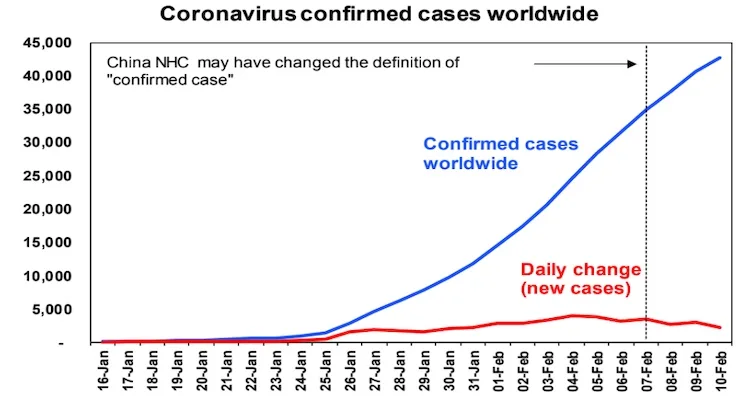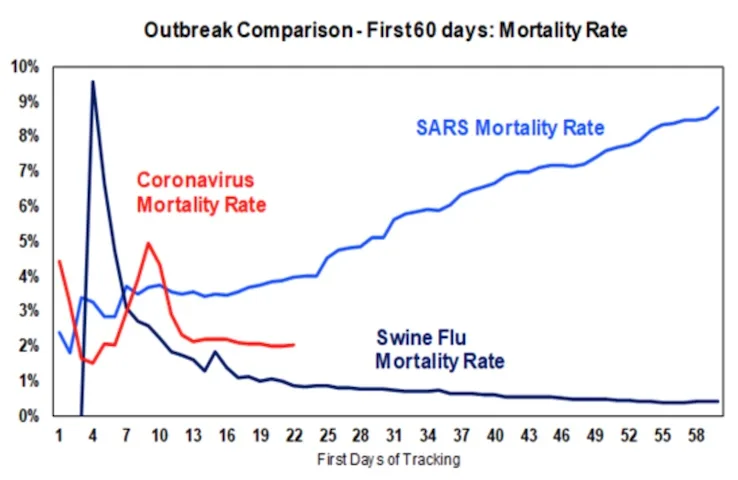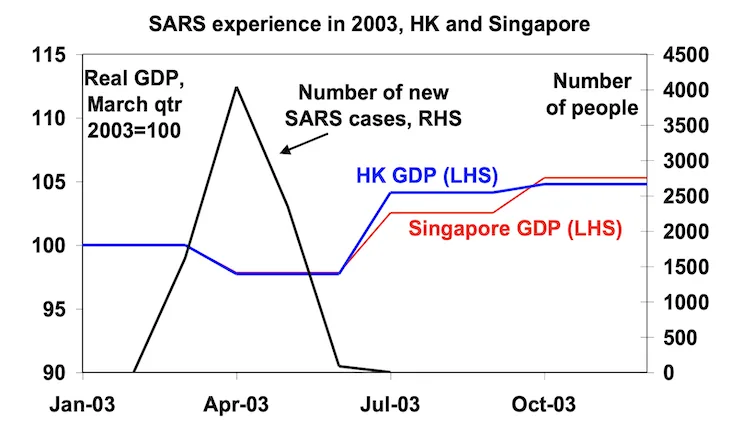Could the coronavirus trigger an economic downturn?


Economist Shane Oliver takes us through data for the coronavirus outbreak and two previous epidemics to show how it could affect both the Australian and global economy.
In the last few weeks, the coronavirus outbreak has led to concern of a global pandemic and the possibility of an economic downturn.
This is first and foremost a human crisis, with the World Health Organisation (WHO) confirming 43,103 cases globally, 1018 deaths and cases spread across 25 countries in its latest situation report (11 Feburary 2020). But it is important to acknowledge that coronavirus – also known as novel coronavirus, 2019-NcoV and COVID-2019 – remains largely contained within China.

Source: PRC National Health Commission, Bloomberg, AMP Capital. Image: Supplied
However, with WHO declaring the outbreak an "international public health emergency", there's growing apprehension over how this could disrupt economic activity.
And signs of an economic slump are starting to show: share markets have seen falls, commodity prices have fallen, and bond yields have collapsed again.
To understand how this could impact the global economy, we can look to past pandemics – both real and feared – to provide more context.
While no two diseases are identical and there is still a lot of uncertainty, here is what our experience with SARS (Severe Acute Respiratory Syndrome) and swine flu tells us:
- Currently the mortality rate of coronavirus is running at approximately 2% which is well above swine flu (0.02%), but well below SARS (which settled around 9%).

Source: PRC National Health Comm, WHO, Johns Hopkins CSSE, AMP Capital. Image: Supplied
- Those who have died from coronavirus have been mainly older people or those with pre-existing conditions.
- Conversely, coronavirus has been more contagious with total cases well above those for SARS (8,000) and people can be infected with no symptoms for two weeks, making contagion easier.
- Containment measures have been much more aggressive and started much earlier than for SARS, especially in China. The Australian government quickly escalated its advice to "do not travel" to China on 1 February 2020, many airlines suspended their flights to the country and quarantine measures were adopted globally.
Ultimately, the economic impact of the coronavirus outbreak depends on how quickly it can be contained. While the higher number of coronavirus cases – compared to SARS and swine flu – suggest greater economic impact, the best way to consider its effect is through potential scenarios:
Scenario 1: Coronavirus is contained by March
If the number of cases continues to rise but mainly within China, and the number of new cases starts to peak in the next month or so, we could see growth rebound in the June quarter.
Under this scenario, Australian growth could take a 0.2% hit this quarter (January – March), mainly due to the loss of Chinese tourists which account for 20% of tourism earnings and 0.2% of GDP. Combined with low consumer confidence and the devastating impact of the bushfires, the GDP could contract further. However, in this scenario, growth would rebound in the June quarter as travel restrictions are removed, people in China go back to work and things return to normal.
Scenario 2: Coronavirus turns into a global pandemic
If the number of new cases snowballs, continues to spread beyond China and isn't contained by mid-year, we would see a bigger and longer negative impact on economic activity.
In this scenario, global travel would collapse, and many would simply no longer go to work. This would cause a sharp decline in global GDP and potentially lead to a global recession. Australia would likely experience two negative quarters of growth as our third-largest export industry – international education – takes a hit.
Reflecting huge economic uncertainty, share markets would likely decline by 20% or so, and cash would be the place to be. However, once the pandemic is under control, economic activity would rebound quickly.
What we need to keep an eye on
To anticipate coronavirus' impact, we need to keep a close eye on:
- The daily number of new cases. In the case of SARS, markets began to rebound once this showed signs of peaking.

Source: Thomson Reuters, AMP Capital. Image: Supplied
- The spread of new cases and deaths in developed countries. If coronavirus remains contained, then markets will become more confident that the economic fallout will be temporary.
While there is reason for concern, SARS, swine flu and other previous outbreaks show that worst-case fears of pandemics rarely eventuate.
Considering how quickly containment measures have been put in place, this provides confidence that the coronavirus outbreak will be contained within a month or so.
It will still impact growth in the current quarter, as China's workforce stays home and travel comes to a halt. While this could cause more downside in share markets and bond yields in the short term, they are likely to rebound by the June quarter as the economic growth rebounds overall.
The biggest uncertainties now are around the reliability of the coronavirus data and whether there will be a mutation making it more harmful.
Shane Oliver is chief economist and head of investment strategy of AMP Capital. He has a PhD in economics and extensive experience analysing economic and investment cycles and what current positioning means for the return potential for different asset classes such as shares, bonds, property and infrastructure. Shane is also a regular media commentator on economic and investment market issues and engages regularly with investors at public events and forums.
Disclaimer: The views and opinions expressed in this article (which may be subject to change without notice) are solely those of the author and do not necessarily reflect those of Finder and its employees. The information contained in this article is not intended to be and does not constitute financial advice, investment advice, trading advice or any other advice or recommendation of any sort. Neither the author nor Finder has taken into account your personal circumstances. You should seek professional advice before making any further decisions based on this information.
Read more Finder X columns
- Best Samung Galaxy S25 Edge pre-order deals (free storage upgrade & more)
- Samsung Galaxy S25 Edge: Price, specs & availability in Australia
- Down the drain: Average Aussie wastes $154 per month
- Fix before they fall: Best term deposit rates for May 2025
- Offset accounts: The great home loan scam or a financial gamechanger?
Images: Getty Images, supplied (AMP Capital)
Ask a question
